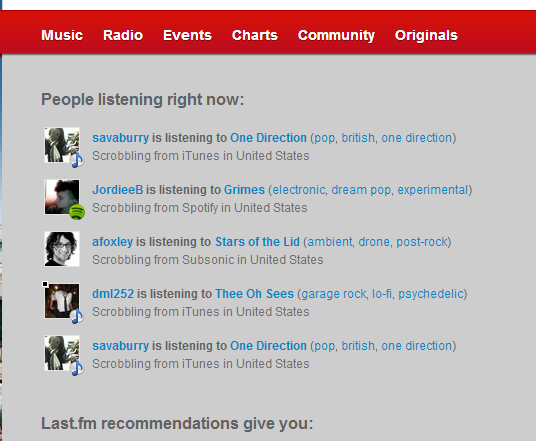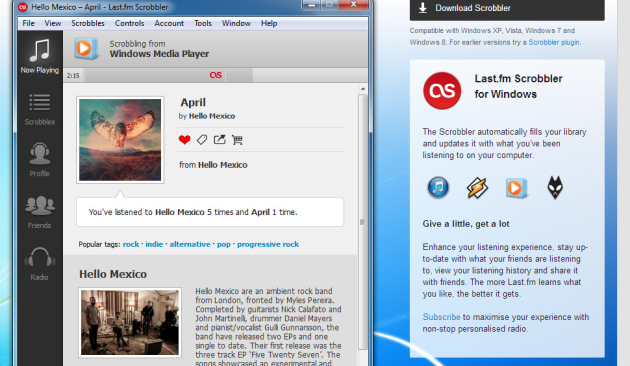Music is a shared district that requires controlled strategies
March 15, 2013 22 Comments
What does ‘Data is the next Intel Inside’ in web2.0 means?
Most web 2.0 applications focuses on database which in terms harnesses the community to participate through data humanisation which leads to a key question commonly asked when it comes to the control over database. “Who owns the data?”
Tim O’Reilly stated that “huge companies such as Microsoft licensed their data as they understood the importance of owning the core database”
The shift between online data and interactive data make us, the users, own the data. The growth in web application’s success is determined by our regular contributions hence, it is important that organisation should focus more on developing an advantage that deals with not only product strategy but also integrating data strategy.
How does Last.fm contribute to the pattern: ‘Data is the next Intel Inside’?
Last.fm is able to harness data for a new outcome that ensures a long-term product utilisation that is beneficial to the organisation and the users. This web base application allows user to generate a list of content of own recommendations where it can be set to private or public view for community sharing.
The application allows users to stream tracks from radio stations, and automatically fills one’s library with updates on what the user have been listening recently. Users can enhance their Last.fm experience by being up to date on recent music that community around the world are listening to.
The data that the user listens to are being contributed to the main source (Last.fm). Last.fm could maximise the users’ data and update the top chart on music recommendations. A large online community can view random Last.fm users on what they are listening in real-time. The term used when people uses the web application to listen to songs is called ‘Scrobbling’.
E.g. Jer Fen is listening to The Lumineers (pop, tags)
Scrobbling from ITunes in Australia
It also links to the social media websites such as Twitter and Facebook. It syncs with your page in Twitter/Facebook with widgets (similar to blogs like wordpress.com that has widgets to showcase at the top, sides and bottom of the webpage) and it will show what tracks has been recently played.
They have an account in Youtube shown below. Youtube is a platform for Last.fm to post videos and interviews with artists appearing for Last.fm across Europe and from their studio in New York.
Last.fm practices best practices. Users control their own data. Users are able to privatise their web application page. Users also control what is being played in their personal library which will be sync to the web application.
Last.fm too ensures that they reserve the right to their logos and does not allow anyone to recreate similar logos that represents Last.fm. Creative common logos are provided for users like myself to download it from their webpage and use it for other purposes such as blogging or advertising.
The advantage of Last.fm is that it does not provide to third parties on user’s personal information that has been recorded into Last.fm database. It is only that the third party information is revealed to the user and it is the user’s full decision to show or ignore his/her interest. It seems that Last.fm is trustable with personal information.
The downsides of Last.fm in terms of ‘Data is the next Intel Inside’ ?
Privacy issues: User can choose whether or not to reveal their real personal information with Last.fm in the policy. As Last.fm relies on users sharing information, withdrawing consent of sharing personal information will mean that the user will not be able to be able to be Last.fm registered user. This means that many features that Last.fm offers are unavailable.
Other Links:
http://www.last.fm/legal/privacy
http://oreilly.com/pub/a/web2/archive/what-is-web-20.html?page=3
http://library.web.cern.ch/library/ailis/pdf/lst08danowski_abstract.pdf
http://radar.oreilly.com/2007/12/google-admits-data-is-the-inte.html
http://googlesystem.blogspot.com.au/2007/12/google-is-all-about-large-amounts-of.html




Hi Jerfen
Your post have given me an insight of ‘Data is the next Intel inside’. Basically musics that users listen recently will fill library which become data. Other users can use that data to listen to the same set of musics. This is a very clear example and easy to understand about this pattern for Web 2.0. People doesn’t listen to only 1 lists of musics and they become bore of the same music overtime and seeking new music to listen to. When people are sad they listen to 1 kind of music. When they are happy they listen to another kind of music. This also apply to situation such as at party, at pubs/bars, and at work. I believe Last.fm can help people finds the music that they want.
Prapat W.
Hi Prapat,
yes, thats exactly what i’ve thought so! And you have a great understanding on the post i uploaded. Thank you! On top of that, users control their own data and the Last.fm website’s products are the users. Cheers!
Hi Jerfen,
Thank you for sharing this post, definitely a new social platform for me to explore.
I like how this web application connects to my other personal social applications like Facebook and Twitter, which allows me to share what I am listening to with my friends. Besides, I discovered that last.fm is a fantastic social interface/application for me to catch up with the latest song chart that is renewed over the weeks. That said, I will never miss out what’s new for music fanatics! I certainly hope all the other readers will share the same sentiments as I do. Cheers!
Wilson.
Hi Wilson,
No, thank you for reading my post!
Yes, and whats great is that Last.fm trust users and i do personally think Last.fm is being trusted by users as well. With 40 million music fans all around, I’m sure this web application suits everyone’s taste on the different sort of musics available in the music industry. Best of all- you get to download the desktop icon for Microsoft, Mac & Linux and start “scrobbling” !
Cheers to you too
Hi Jerfen,
Your blog gives an excellent example of how ‘Data is the next Intel Inside’ even within Web 2.0. Data is becoming such an important commodity inside web 2.0, just like your example about Last.fm users listening to music could allow Last.fm to maximise the users’ data and update the top chart on music recommendations. These data can be then shown to the general public on what the latest hits are or what the people are listening in real time.
Just wondering so if you do not want to share your personal information can you still use Last.fm?
Andy
Hi Andy,
Thanks! & regarding to your question on whether people still are able to use Last.fm if they do not share their personal information to Last.fm. – as stated in my blog post “withdrawing consent of sharing personal information will mean that the user will not be able to be able to be Last.fm registered user. This means that many features that Last.fm offers are unavailable.” – Regarding to this, Yes, you still can use Last.fm but the features available to you are limited. You will not be able to gain the full access features if you’re not a registered user. I hope this answers your question. 🙂
I see now thanks for clearing that up, you can still use their website however without sharing your personal data they wont allow you to use the full features, shows how important users data is becoming.
Hi Jerfen
Very vivid description of Last.fm, however, what are they actually doing with the data? I know that they are suggesting music to other people with similar interests, and you state “The advantage of Last.fm is that it does not provide to third parties on user’s personal information that has been recorded into Last.fm database”.
How is Last.fm a successful application? Do they make revenue from ads on the website, sell premium services or something else?
Cheers
Aleks
Hi Aleks,
Thanks! There are two kinds of data that i mentioned in Last.fm.
1. Personal Information to be a registered user.
2. Data that user’s upload
If you’re speaking about User’s upload data, the answer that you may be seeking for can be found here: http://www.last.fm/legal/terms#para12
If you’re speaking about personal information to be a registered user, user may be able to purchase a subscription for certain additional features of the Website and Services therefore personal information is needed for validation purposes and to ensure that accounts are not being passed around.
Last.fm is a successful application based on the number of users. 40 million active/registered users .Yes, they do make money for ads too. On the website itself, Vodafone is the main contributor for the advertisements and advertisements do not come free. More can be found here: http://crave.cnet.co.uk/digitalmusic/last-fm-interview-behind-the-music-49304380/
Cheers
Pingback: Data is the next Intel inside | My Blog 2.0
Hi Jerfen,
Great post! Having heard of but never having used Last.fm I am now intrigued and am likely to set up an account for myself shortly. I never realised that it was a whole different application in its own right, rather than a competitor to programs like itunes. Overall a very informative post and an excellent example of the pattern of ‘Data is the Next Intel Inside’.
– Matt
Thankyou Matt 🙂
Hi Jerfen,
Lastfm is very interesting and I plan to take to try it out. The way that it uses the data from users is also unique and clever. In your opinion, do you think websites that collects user information should be allowed to reuse the information in a way by redistributing it to other sites?
-Sukshan
Hi Sukhshans,
well, in my own opinion, i do think that websites should be allowed to reuse information. Depending on what kind of information can be shared depending on the user’s agreements. I would think that it is good for any websites to create a poll for each individual users and tick on any information they think it is “alright and acceptable” to share to other sites. In this case, this could be captured in the website’s database system and allowing the system to validate whose information and what information can be distributed.
Another great site, thanks Jerfen. I liked the information you provided about Last.fm and it sounds like a great and easy way to listen and manage your radio music.
I have a question similar to Aleks one. What is the value of the data and they and to whom? How do you see it being used?
I did a post on LinkedIn ( http://wp.me/p3fP2b-1Y )and I know that recruiters are keen to get their hands on that data. I just wonder who will be using the data from Last.FM and for what purpose?
Also, do they have any geographic location data? That bothers my personal security a bit.
Hi Brownynsc,
The value and purpose of the gathering data which is being stored inside Last.fm database system nd the purpose of using the data is for personal gains such as user whom may purchase a subscription for certain additional features of the Website and Services therefore personal information is needed for validation purposes and to ensure that accounts are not being passed around. Third parties such as bank are able to use the information for validations when using credit cards for payment.
Geographical location wise, Yes, as it stated in the first picture above in the post itself, it states ” Scrobbling from United Stated” That is a geographical location, but it definitely do not state your address as i do also think that it is dangerous. It only shows the city/state.
Thanks Jerfen – that helped me understand a bit more.
🙂
Hi Jerfen,
Your post gave me a great insight on Lastfm, this sounds like something I should try out. I like how it gives users that social aspect of music sharing, something different to the usual social media platforms that are available.
I see that Spotify is very similar to Lastfm in some ways. Would there be any advantages of using Lastfm over Spotify or any other music sharing platform available?
Thanks, Rob
Hi Rob,
Well i’ve gone to the website of Spotify and i do personally think that Lastfm and Spotify are very similar.
However both applications will have their own advantages.
Lastfm however is not able to play music in stereos, TVs, speakers, cars and more while Spotify can. Thanks for introducing Spotify! i now do think that Spotify is more user-friendly than Lastfm! 🙂
Hi Jerfen 🙂
Great post! I agree with the privacy issues, I can definitely see how people turning of the sharing and “scrobbling” aspects of Lastfm can be potentially detrimental for business.
Lastfm seems to put practices to good use such as outsourcing. I like how it shows people all over the world what they are “scrobbling” on their different music player software. It looks like a great, innovative way to advertise both the music and the music player software! Are users able to comment and rate music on Lastfm like on iTunes? Enabling that option would be a great way to put the practice of users enhancing the data to good use!
Great post and info Jerfen! Kind regards, Laura 🙂
Hi Laura,
Thank you so much! you’re too kind! 😉
Well, users are able to comment on Last.fm base on this website > http://www.last.fm/api/show/user.shout (but it may not seem easy for some users)
Ratings of music, unfortunately you cant rate them! but still thanks for the option. It helps me to foresee what kind of improvements Last.fm can integrate!